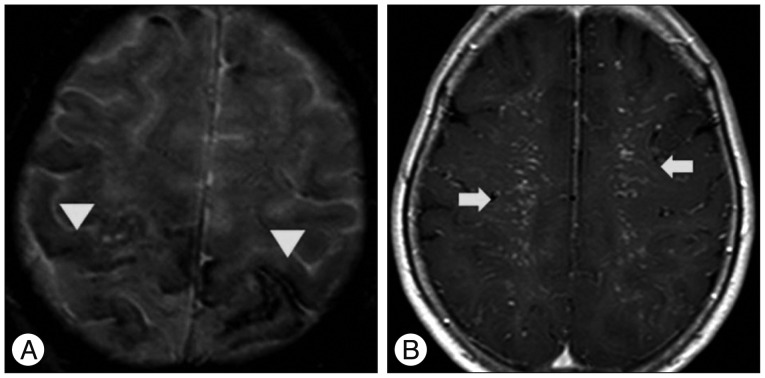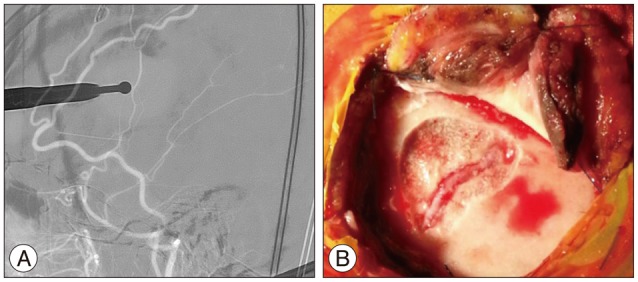1. Cognard C, Gobin YP, Pierot L, Bailly AL, Houdart E, Casasco A, et al. Cerebral dural arteriovenous fistulas : clinical and angiographic correlation with a revised classification of venous drainage. Radiology. 1995; 194:671–680. PMID:
7862961.

2. Fukai J, Terada T, Kuwata T, Hyotani G, Raimura M, Nakagawa M, et al. Transarterial intravenous coil embolization of dural arteriovenous fistula involving the superior sagittal sinus. Surg Neurol. 2001; 55:353–358. PMID:
11483194.

3. Gross BA, Ropper AE, Popp AJ, Du R. Stereotactic radiosurgery for cerebral dural arteriovenous fistulas. Neurosurg Focus. 2012; 32:E18. PMID:
22537127.

4. Halbach VV, Higashida RT, Hieshima GB, Rosenblum M, Cahan L. Treatment of dural arteriovenous malformations involving the superior sagittal sinus. AJNR Am J Neuroradiol. 1998; 9:337–343. PMID:
3128082.
5. Houdart E, Saint-Maurice JP, Chapot R, Ditchfield A, Blanquet A, Lot G, et al. Transcranial approach for venous embolization of dural arteriovenous fistulas. J Neurosurg. 2002; 97:280–286. PMID:
12186454.

6. Ihn YK, Kim MJ, Shin YS, Kim BS. Dural arteriovenous fistula involving an isolated sinus treated using transarterial onyx embolization. J Korean Neurosurg Soc. 2012; 52:480–483. PMID:
23323170.

7. Kakarla UK, Deshmukh VR, Zabramski JM, Albuquerque FC, McDougall CG, Spetzler RF. Surgical treatment of high-risk intracranial dural arteriovenous fistulae : clinical outcomes and avoidance of complications. Neurosurgery. 2007; 61:447–457. discussion 457-459. PMID:
17881955.
8. Kiyosue H, Hori Y, Okahara M, Tanoue S, Sagara Y, Matsumoto S, et al. Treatment of intracranial dural arteriovenous fistulas : current strategies based on location and hemodynamics, and alternative techniques of transcatheter embolization. Radiographics. 2004; 24:1637–1653. PMID:
15537974.

9. Koh JS, Ryu CW, Bang JS, Lee SW. Transcranial Approach for Arterial Embolization of Dural Arteriovenous Fistula Within the Wall of the Superior Sagittal Sinus. A Case Report. Neurointervention. 2007; 2:117–121.
10. Kurl S, Saari T, Vanninen R, Hernesniemi J. Dural arteriovenous fistulas of superior sagittal sinus : case report and review of literature. Surg Neurol. 1996; 45:250–255. PMID:
8638222.
11. Luo CB, Chang FC, Wu HM, Chung WY. Transcranial embolization of a transverse-sigmoid sinus dural arteriovenous fistula carried out through a decompressive craniectomy. Acta Neurochir (Wien). 2007; 149:197–200. discussion 200. PMID:
17091209.

12. Oh JT, Chung SY, Lanzino G, Park KS, Kim SM, Park MS, et al. Intracranial dural arteriovenous fistulas : clinical characteristics and management based on location and hemodynamics. J Cerebrovasc Endovasc Neurosurg. 2012; 14:192–202. PMID:
23210047.

13. Ohara N, Toyota S, Kobayashi M, Wakayama A. Superior sagittal sinus dural arteriovenous fistulas treated by stent placement for an occluded sinus and transarterial embolization. A case report. Interv Neuroradiol. 2012; 18:333–340. PMID:
22958774.

14. Pierot L, Visot A, Boulin A, Dupuy M. Combined neurosurgical and neuroradiological treatment of a complex superior sagittal sinus dural fistula : technical note. Neurosurgery. 1998; 42:194–197. PMID:
9442524.

15. Toyota S, Fujimoto Y, Wakayama A, Yoshimine T. Complete Cure of Superior Sagittal Sinus Dural Arteriovenous Fistulas by Transvenous Embolization through the Thrombosed Sinus in a Single Therapeutic Session. A Case Report. Interv Neuroradiol. 2008; 14:319–324. PMID:
20557730.







 PDF
PDF ePub
ePub Citation
Citation Print
Print






 XML Download
XML Download